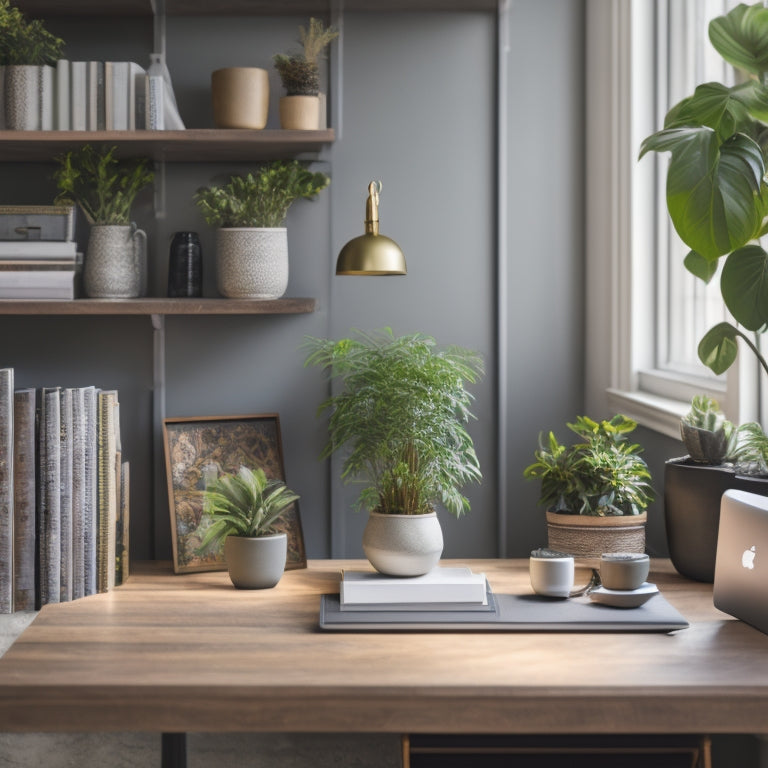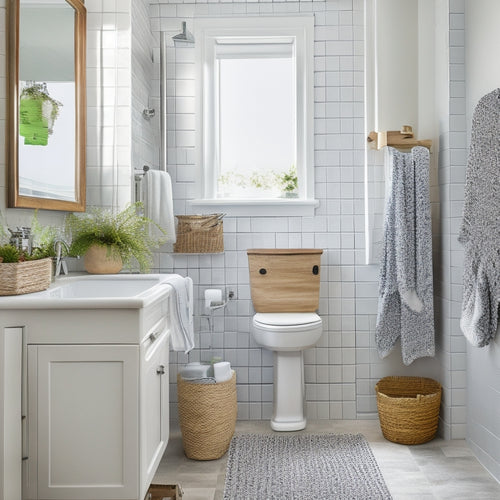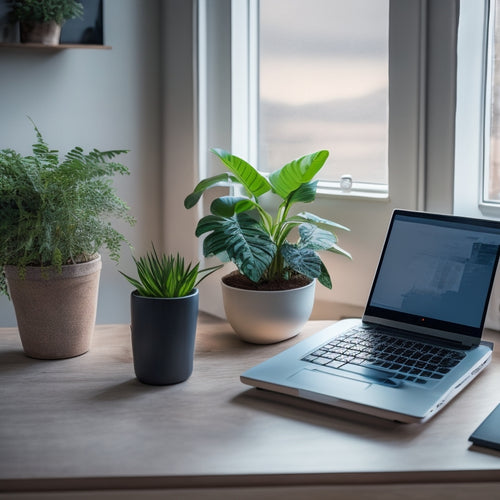
Organize Your Space: Effective Study Area Setup
Share
To set up an effective study area, start by decluttering and cleaning your space. Sort items into keep, donate, and throw away piles, and invest in storage solutions like bins or baskets. Next, optimize your desk and chair placement to promote good posture and reduce strain. Consider a corner setup and make sure your desk is at a comfortable height. Store study materials in labeled bins and designate areas for your laptop and notebook. By following these steps, you'll be well on your way to creating a productive workspace that helps you stay focused and efficient - and there's even more you can do to take your study space to the next level.
Key Takeaways
• Clear clutter and distractions from your study area to promote focus and mental clarity.
• Optimize your desk and chair for ergonomic comfort and reduced physical strain.
• Utilize storage solutions like bins, baskets, and shelves to keep study materials organized and within reach.
• Minimize digital distractions by setting boundaries on social media, email, and app usage during study sessions.
• Create a conducive study ambiance with proper lighting, calming colors, and motivational decor to boost productivity.
Decluttering for a Fresh Start
Clear everything off your study area, including old notes, empty water bottles, and last week's leftovers, to create a clean slate that sparks focus and motivation. This mindful purge is essential to setting up an effective study area.
Start by sorting items into three piles: keep, donate/recycle, and throw away. Be ruthless – if you haven't used it in the past month, it's probably safe to get rid of it. Once you've purged your unwanted items, give your study area a good clean. Dust, vacuum, and wipe down surfaces to create a fresh canvas for your new study setup.
Now that your space is clear, take a step back and assess what you need to bring back into your study area. Only put back the essentials, such as your laptop, notebooks, and necessary school supplies. Organize these items in a way that makes sense for your study style, and consider investing in storage solutions like bins or baskets to keep clutter at bay.
With a clean and organized study area, you'll be able to focus on your studies without distractions, and you'll be more motivated to tackle your work.
Optimal Desk and Chair Placement
Now that your study area is clutter-free, it's time to focus on setting up your desk and chair for maximum productivity.
You'll want to position your desk in a way that allows you to work comfortably, with enough space to spread out your materials and minimal distractions.
Desk Positioning for Comfort
Position your desk in a way that allows you to sit comfortably with your feet flat on the floor or on a footrest, keeping your knees at or below hip level. This will help you maintain good body alignment, reducing strain on your back and legs.
Consider a corner setup, which can provide more space and flexibility for your study area. Place your desk at a 90-degree angle to the wall, allowing you to sit comfortably with your back straight and your shoulders relaxed. This setup also allows you to easily access books, notes, and other study materials.
When positioning your desk, make sure it's at a comfortable height for you. You should be able to sit with your elbows at a 90-degree angle and your wrists straight. Avoid placing your desk in a way that forces you to hunch over or stretch to reach your materials.
Ergonomic Chair Alignment
Align your chair to fit snugly under your desk, with your knees at or below hip level and your feet flat on the floor or on a footrest, allowing you to maintain a 90-degree angle between your thighs and torso. This position guarantees your chair height is ideal, promoting good posture and reducing strain on your back.
When adjusting your chair height, keep in mind that your elbows should be at a 90-degree angle, and your wrists should be straight, allowing your arms to rest comfortably on the armrests.
Proper spine curvature is also essential. Adjust your chair to encourage a natural, S-shaped spine curve. Avoid slouching or leaning forward, which can lead to discomfort and fatigue. Instead, sit up straight, with your shoulders relaxed and your head level. This will help you stay focused and maintain energy throughout your study sessions.
Storage Options for Study Materials
You'll need a system to keep your study materials organized and within easy reach, and that's where clever storage options come into play.
A clutter-free study area is essential for focus and productivity. Here are some storage solutions to explore:
-
Shelf dividers: Separate your books, notes, and other materials into categorized sections, making it easy to find what you need in a snap.
-
File cabinets: Store important documents, such as assignments and project materials, in a secure and organized manner.
-
Desk organizers: Keep your workspace tidy with designated slots for pens, papers, and other office supplies.
-
Stackable bins: Store items like paper, folders, and binders in labeled bins, keeping them out of the way but still accessible.
-
Cubbyhole shelves: Designate a specific area for your most frequently used items, like textbooks or laptops, to keep them within easy reach.
Maximizing Vertical Space Potential
To optimize your study area's vertical space, consider installing shelves, hooks, or a pegboard on walls or the back of a door to hang items like bags, accessories, or frequently used resources. This will help keep your floor and surfaces clear, creating a more organized and focused study environment.
Wall shelves are particularly useful for storing books, binders, and other study materials that you need quick access to. You can also use shelf dividers to categorize and separate your materials, making it easier to find what you need when you need it.
Creating a Productive Workspace
Now that you've maximized your vertical space, it's time to focus on creating a productive workspace that helps you stay focused and efficient.
To achieve this, you'll need to tackle three key areas: your surroundings, your desk, and digital distractions.
Declutter Your Surroundings
Clearing everything off your study area except the essential items you need to focus on your task is crucial. A cluttered space can greatly hinder your ability to concentrate. Clutter psychology suggests that a cluttered environment can lead to mental fogginess, making it difficult to stay focused and motivated.
By decluttering your study area, you're creating a space sanctuary that promotes mental clarity and productivity.
Here are some things you should remove from your study area:
- Old notes and papers that are no longer relevant
- Broken or non-functional stationery items
- Dirty dishes or empty food containers
- Unnecessary decorative items that distract you
- Clothes or accessories that aren't related to your study session
Optimize Your Desk
By carefully arranging your essential items, you can create a functional and efficient workspace that streamlines your study process and boosts your productivity. Start by designating a specific area for your laptop, notebook, and writing utensils. This will help you stay focused and avoid clutter.
Consider investing in a desk organizer or tray to keep small items, such as paper clips and pushpins, within easy reach.
Next, think about Desk Decor. Add a few plants or a fun mug to make your space more inviting, but avoid over-accessorizing, which can be distracting.
Now, tackle Cord Management by using cable organizers or zip ties to keep your cords tidy. This will reduce visual clutter and make it easier to find what you need.
Minimize Digital Distractions
Remove digital distractions by setting your phone to 'do not disturb' mode and logging out of social media tabs on your laptop, allowing you to concentrate on the task at hand. This simple step can greatly enhance your productivity.
However, if you need more help staying focused, consider implementing these strategies:
-
Use app blocking tools to restrict access to distracting websites or apps during certain times of the day or for a set period.
-
Set screen limits on your devices to remind you to take breaks and avoid burnout.
-
Remove notifications from your study area by silencing your phone or turning off notifications on your laptop.
-
Consider using a website blocker or productivity app to track your time and stay on task.
-
Schedule specific times for checking social media or personal emails to avoid mindless scrolling.
Effective Lighting for Focus
Effective Lighting for Focus
Position your study lamp to cast a soft, indirect glow on your workspace, allowing your eyes to focus comfortably on the material in front of you. This will help you maintain concentration and reduce eye strain.
To achieve the perfect ambiance, consider the natural ambiance of your study area. If you're studying during the day, take advantage of natural light by placing your desk near a window. In the evening, use artificial light sources with a warm color temperature (around 2700K-3000K) to create a cozy atmosphere.
Avoid harsh overhead lighting, which can be distracting and uninviting. Instead, opt for task lighting that directs light exactly where you need it. By doing so, you'll create an environment that promotes focus and productivity.
Personalizing Your Study Oasis
You can curate a study space that reflects your personality and learning style by incorporating personal touches that inspire motivation and comfort. This is where you get to make your study area truly yours, and it's essential to create an environment that boosts your productivity and focus.
Here are some ideas to get you started:
-
Choose a soothing color scheme: Select colors that calm your mind and stimulate your creativity. For example, blue is often associated with focus, while green is linked to calmness.
-
Display inspirational quotes: Place motivational quotes around your study area to keep you driven and motivated.
-
Add some greenery: Plants can purify the air, reduce stress, and boost your mood.
-
Personalize your decor: Hang up posters, photos, or artwork that inspire you or make you happy.
-
Incorporate comfort elements: Add a cozy rug, a comfortable chair, or a soft blanket to create a sense of relaxation.
Frequently Asked Questions
How Do I Stay Motivated to Maintain My Organized Study Space?
To stay motivated, you'll create a reward system, treating yourself after reaching study goals, and find an accountability partner to regularly check-in, ensuring you maintain your organized space and stay on track.
Can an Organized Study Space Really Improve My Academic Performance?
Imagine Sarah, a college freshman, who transformed her cluttered dorm room into a peaceful oasis, and saw her GPA jump from 2.8 to 3.5. You'll experience similar success by creating a learning environment that fosters good study habits, boosting your academic performance.
Are There Any Specific Colors That Can Enhance Focus and Productivity?
You can boost focus and productivity by surrounding yourself with specific colors. According to Color Psychology, calming hues like blue, green, and yellow can stimulate your mind, reducing distractions and increasing mental clarity.
How Often Should I Clean and Reorganize My Study Area?
You should establish daily habits like tidying up for 10 minutes and incorporate weekly routines, such as deep cleaning and reorganizing, to maintain a clutter-free and focused study area that boosts your productivity.
Can I Still Have Decorative Items in an Organized Study Space?
You can still showcase your personality through decorative items, but strike a balance between personal expression and minimalist chic. Choose a few meaningful pieces that inspire you, and arrange them thoughtfully to maintain a clutter-free study space.
Related Posts
-

Bathroom Storage Hacks for Small Spaces Revealed
You're about to discover the ultimate bathroom storage hacks for your small space! Start by maximizing your vertical ...
-

Declutter Your Desk With These Online Tutorials
You're just one organized desk away from boosting your productivity, reducing stress, and achieving a sense of contro...

